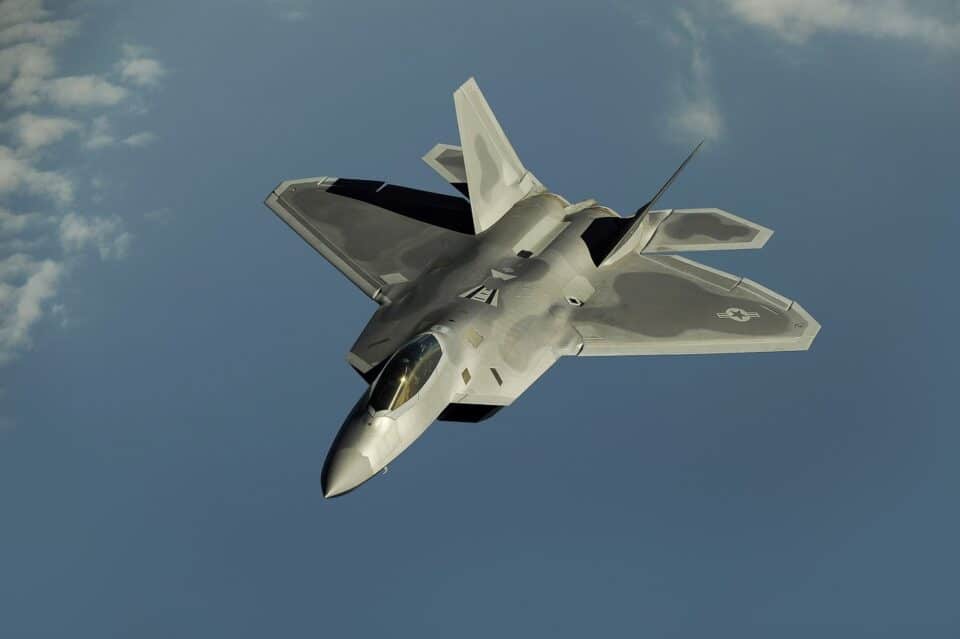Aerospace
F-22 Raptor jet sets new record, 28 air-to-air missiles loaded & fired
#F-22 #Raptor breaks new record for most missiles loaded and fired

The 94th Fighter Squadron at Tyndall Air Force Base in Florida smashed the previous record for the most air-to-air missiles loaded and successfully fired by an F-22 Raptor.
28 air-to-air missiles valued at more than $14 million
As a cohesive team, the units employed 28 air-to-air missiles valued at more than $14 million during WSEP 22.12, deeming them the most successful unit to attend a WSEP thus far. They also demonstrated a high level of proficiency while shooting the F-22’s six-barrel, 20mm Gatling gun, and the M61A2 Vulcan at the Advanced Gunnery Target System.
The Lockheed Martin F-22 Raptor is an American single-seat, twin-engine, all-weather stealth tactical fighter aircraft produced for the US Air Force. Despite being designed as an air superiority fighter, the aircraft can also conduct ground assaults, engage in electronic combat, and gather signals intelligence. While Lockheed Martin, the F-22’s prime contractor, built the majority of the aircraft’s airframe and weapon systems and oversaw final assembly, Boeing provided the aircraft’s wings, aft fuselage, avionics integration, and training systems.
F 22 specifications
This aircraft can be operated by a single crew and has a wingspan of 44 feet, a height of 16 feet, and a length of 62 feet. Four 5,000-pound-capable underwing hardpoints are present on the F-22. At altitude, it can reach a top speed of Mach 2.25, or up to 2,414 km/h. It can fly at a height of 65,000 feet and has a combat range of 850 km and a ferry range of 3,220 km.
IAF to induct first batch of domestically built LCH at Jodhpur (Opens in a new browser tab)
The F-22 has a maximum altitude of 10 miles and is capable of sustained supersonic flight. Without using afterburners, the F-22 flies at a speed of above Mach 1.5 thanks to “Supercruise.” Even at high speeds, the F-22 Raptor can accelerate swiftly and make razor-sharp maneuvers.
Weapons aboard the F-22 fighter jet are primarily intended for use against airborne targets. It’s important to understand that the pilot can launch standoff attacks on ground targets. Lethal long-range air-to-air and air-to-ground armament are among the US F-22’s many strengths. The F-22 fighter uses stealth technology to operate almost radar-undetected.
10 Most Expensive Fighter Jets In The World(Opens in a new browser tab)
Only 195 aircraft had been built.
The fifth-generation fighter jet, the F-22, made its debut in 2005 after making its first flight on September 7, 1997. Owing to technological confidentially, the export of this aircraft was restricted. Additionally, the manufacture of this aircraft ceased in 2011 due to an expensive budget program. Despite this, Lockheed Martin improved its technology to keep up with the current generation of fighter jets. So far, only 195 aircraft had been constructed.

Aerospace
Boeing Transfers Rocket Stage to NASA, Paving Way for Human Moon Mission

Boeing has achieved a significant milestone by providing NASA with the second core stage of the Space Launch System (SLS) rocket.
This crucial component, crafted at NASA’s Michoud Assembly Facility (MAF), is set to propel the Artemis II crew into lunar orbit, marking humanity’s return to deep space after a 50-year hiatus.
The monumental Boeing-built rocket stage, the largest element of the Artemis II mission, will embark on a journey aboard the Pegasus barge, traveling 900 miles to NASA’s Kennedy Space Center.
Comparison of two legendary aircraft B777x vs B747 aircraft:Click here
Upon arrival, it will be meticulously integrated with other essential Artemis II components, including the upper stage, solid rocket boosters, and NASA’s Orion spacecraft within the iconic Vehicle Assembly Building. This intricate integration process is a vital step toward the eagerly anticipated Artemis II launch, slated for 2025.
“Boeing-built products helped land humankind on the moon in 1969, and we’re proud to continue that legacy through the Artemis generation,” remarked Dave Dutcher, vice president and program manager for Boeing’s SLS program. “Together, with NASA and our industry partners and suppliers, we are building the world’s most capable rocket and paving the way to deep space through America’s rocket factory in New Orleans.”
NASA, Lockheed Martin Reveal X-59 Quiet Supersonic Aircraft:Click here
The delivery of Core Stage 2 marks a significant achievement in the evolution of the SLS rocket. Towering over 200 feet and powered by four RS-25 engines, this core stage, coupled with two solid-fueled booster rockets, will generate a staggering 8.8 million pounds of thrust. This immense power is crucial to launching Artemis II and future missions into the vast expanse of space.
The SLS rocket stands unparalleled in its capability to transport both crew and substantial cargo to the moon and beyond in a single launch. Its extraordinary capacity will facilitate the delivery of human-rated spacecraft, habitats, and scientific missions to destinations including the moon and Mars, ushering in a new era of space exploration.
-

 Travel1 week ago
Travel1 week agoAir India to Expand US Operations with Three New Routes After a Decade
-

 Travel2 weeks ago
Travel2 weeks agoWhy We Should Avoid These Stamps in a Passport
-

 Airlines1 month ago
Airlines1 month agoInvestigations Reveal Fake Chinese Titanium in Boeing and Airbus Jets
-

 Tech4 weeks ago
Tech4 weeks agoChina’s CATL Plans 1,800-Mile Electric Plane Launch by 2027
-

 Airport3 days ago
Airport3 days agoTop 10 Largest Airports in the World by Size
-

 Aerospace4 weeks ago
Aerospace4 weeks agoChina’s Fighter Jets Turn Wings into Autonomous Drones
-

 Airlines4 days ago
Airlines4 days agoAir India Rolls Out A350s for Delhi-New York JFK and Newark Routes
-

 Defence3 weeks ago
Defence3 weeks agoBoeing Enhances Chinook with New Engines and Block II Upgrades at $96 Million







